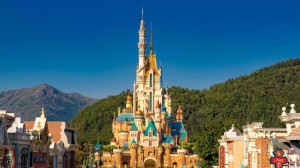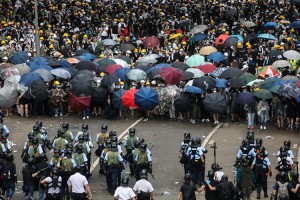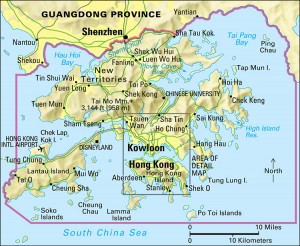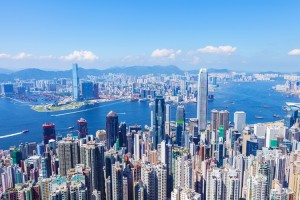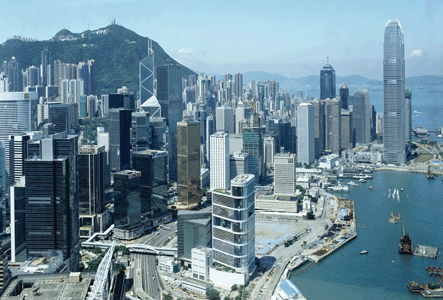Pour the Syrup; It’s National Waffle Day!
Wednesday, August 24th, 2022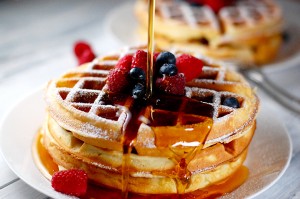
Waffles are often served for breakfast with syrup and fruit.
Credit: © olga’s captured moments/Shutterstock
Popular mouth-watering breakfast foods include doughnuts, french toast, pancakes, and sugary cereals. Typical savory breakfast items may include bacon and sausage, biscuits and gravy, eggs in any form, and hash browns or other potatoes. Few items can cross the divide of sweet and savory as well as the waffle.
The waffle is a crisp batter cake made from flour, eggs, and sugar. A waffle is made by baking batter in a grooved and heated press until it crisps. The press is a hinged appliance called a waffle iron that typically makes a gridlike pattern on the cakes. The waffle iron can be designed to produce a variety of shapes. People enjoy waffles for their golden color, crisp exterior, fluffy texture, and sweet taste.
In the United States, waffles are usually served with butter, syrup, and perhaps fruit for breakfast. They are also served in such savory dishes as the popular American combination of chicken and waffles. Waffles are also served in dessert dishes, commonly with ice cream.
Waffles can be traced back to the 1200’s in Europe. Dutch and German people brought waffle irons when they immigrated to the United States. In the 1700’s, many wealthy American families owned waffle irons and made waffles for special occasions. In the mid-1800′s, waffles became a staple of hotel menus for breakfast along with options topped with meat and gravy for dinner. The electric waffle iron was introduced in the early 1900’s and became a popular wedding gift.
Most waffles consist of flour, baking powder, eggs, milk, sugar, and butter or vegetable oil. The batter may be mixed with such sweeteners as honey, brown sugar, and chocolate chips, as well as such other ingredients as bacon, oats, nuts, and fruit. Toppings for breakfast waffles include butter, fruit, honey, jam, powdered sugar, maple syrup, and whipped cream.
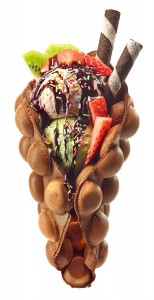
In Hong Kong, egg waffles or bubble waffles are often served as a cone with ice cream.
Credit: © baibaz/Shutterstock
Many countries have different popular versions of the waffle. Perhaps the best-known is the Belgian waffle. The batter is baked in a hot iron grid to create a large, fluffy waffle. In Hong Kong, the egg waffle or bubble waffle is a popular dessert. It often is used as a cone to hold ice cream. In the Netherlands, the Liege waffle is made with sugar and paired with coffee. Also in the Netherlands, the Dutch stroopwafel is two thin cookie-like wafers with caramel sandwiched between.
A waffle is a type of quick bread. Other quick breads include corn bread, doughnuts, muffins, and pancakes. Most quick bread is baked at home or in local bakeries and supermarkets. Waffles are very similar to pancakes. Many types of waffles are sold in grocery stores and restaurants and made at home. At home, waffles may take about 20 minutes to prepare and about 5 minutes to cook. Ready-to-eat frozen waffles require only heating in the toaster or microwave. Eggo Food Products Inc. introduced frozen waffles in the 1950’s. At the time, freezers and frozen foods were gaining popularity in American households and grocery stores. Frozen waffles offered ready-made convenience for parents and kids. The product could be placed directly in the toaster for a few minutes.
Gluten-free and vegan waffles can be made with substitutes for butter, eggs, flour, and milk. Boxed mixes are sold in grocery stores ready to mix with just water or very few ingredients. Today, manufacturers fortify many ready-to-eat waffles with extra nutrients. Such waffles can include high-fiber and whole-grain varieties. Breakfast waffles consist largely of energy-producing carbohydrates and may contain added protein, depending on the ingredients.

